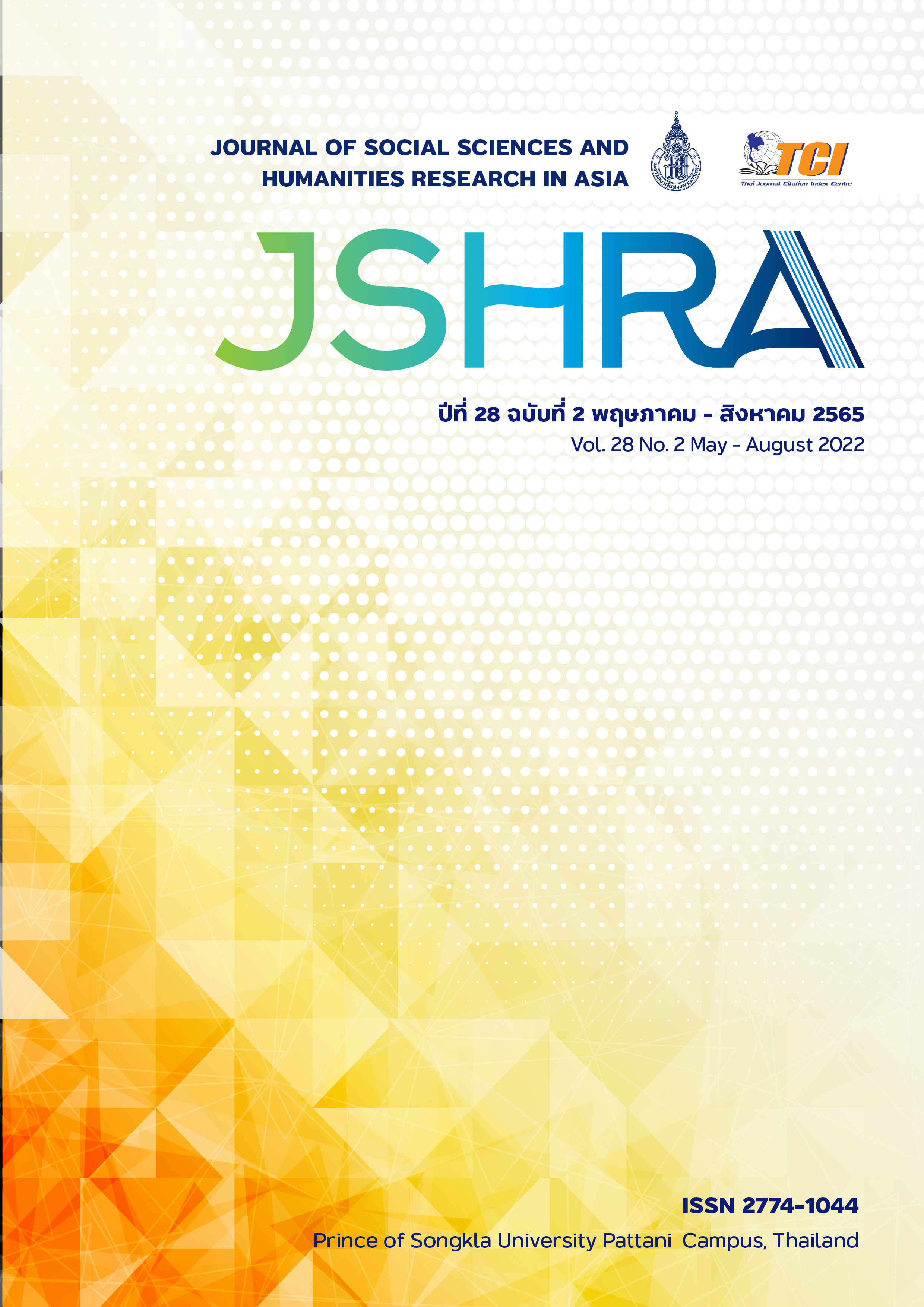A Comparison of Culture and Wisdom of Using Pandanus Leaves Among Polynesia, Hawaii and the Andaman Coast of Thailand
Keywords:
Andaman, Culture, Hawaii, Pandanus Leave, WisdomAbstract
The purposes of this study included studying and comparing cultures and the wisdom of using pandanus leaves between the Polynesian area in Hawaii and Thailand on the Andaman coast. Research methods are based on the review of relevant documents and information as well as analyzing the data. The results of the study can be summarized into 3 aspects. 1) Ethnobotany: Pandanus grow on the coast. The main species in Hawaii is Pandanus tectorius, while the main species in Thailand are Pandanus Odorifer - which is synonymous with Pandanus Odoratissimus. Pandanus leaves with thorns look like sticky leaf plates. There is a luster to it. When processed into strips for handicrafts, its properties are flexibility, toughness, sun resistance, not moldy, which both areas have used pandanus leaves with use for living. 2) Social and Cultural Aspects: Although Hawaii has the use of pandanus leaves for both to build vernacular architectures and make sails. Both areas also create lifestyle handicrafts and ceremonial objects. Additionally, they use handicrafts from pandanus leaves as a cultural exchange instead of money. The continuation of wisdom in the form of learning from families and teachers, nonetheless they are currently facing social and economic changes nowadays, whereas people in both areas are developing their traditional insight to be the products that can fulfill the needs of consumers 3) The Environment: The Andaman region has the intelligence of cutting pandanus trees and maintains them to be able to use for revolving manner. Despite this, the threat of plants and pandanus damaged insects that affect the artisans in Hawaii. The encroachment of agricultural forests in the Andaman region motivates their community to conserve coastal forests that also benefit the succession of the pandanus community by sustainable progress.
References
Aekutraporn, P. (2021). Continuing on the way of craftsmanship in the southern region: Panan Pandanus-Na Mun SI woven fabric to sustainable international. Retrieved February 28, 2022, from https://kooper.co/sacict-trang-handicraft/
Abbott, I.A. (1992). “Lāʻau Hawaiʻi: Traditional Hawaiian uses of plants”. Honolulu: Bishop Museum Press.
Baanwanghin Pandanus’s Handicraft Group. (2020). Panan pandanus basketry. Retrieved August 20, 2020, from https://www.padanashop.com/article/เครื่องจักสานจากเตยปาหนัน
Bhattacharya, A. (2014). Safeguarding ICH & sustainable development. Retrieved November 15, 2021, from http://www.ichngoforum.org/safeguarding-ich-sustainable-development
Bird, A.J., Goldsberry, S., & Bird, J.P. (1982). The craft of Hawaiian lauhala weaving. Honolulu: University of Hawaii Press.
Bown, D. (1995). Encyclopedia of herbs and their uses. London: Dorling Kindersley.
Bunnag, R. (2013). Cultural Heritage. Retrieved December 5, 2020, from http://www.marutbunnag.com/article/417/
Callmander, M.W., Gallaher, T.J., McNeill, J., Beentie, H., Nadaf, A.B., Middleton, D.J., & Buerki, S. (2020). Neotypification of Pandanus odorifer, the correct name for P. odoratissimus (Pandanaceae). Taxanon, 70(1), 182-184.
Cambridge Dictionary. (2022). Retrieved Febuary 15, 2022, from https://dictionary.cambridge.
org/dictionary/english/polynesia
Chaipakdee, J. (2022). Change “pandanus” to “money” panan pandanus weaving: From local wisdom value added. Retrieved December 20, 2021, from https://www.technologychaoban.com/bullet-news-today/article_199790
Ching, J.C. (2019). Culture and arts-heritage and aloha at Kimura Lauhala Shop. Retrieved July
, 2020, from https://www.thehawaiiherald.com/2019/07/11/culture-and-arts-heritage-
and-aloha-at-kimura-lauhala-shop/
Collins Dictionary. (2022). Retrieved Febuary 15, 2022, from https://www.collinsdictionary.com/dictionary/english/
Cunningham, J. (1994). Fossil discovery proves Stone’s theory is correct. Texas: Iridos.
Department of Cultural Promotion. (2016). Culture, lifestyle and local wisdom. Nakhon Pathom: Rung Silp Printing (1977).
Department of Land and Natural Resources of Hawaii. (2021). Hala. Retrieved October 15, 2021, from https://dlnr.hawaii.gov/forestry/info/big-tree/hawaii-state-big-tree-competition/hala/
Frailey, S. (2015). The art and history behind our lauhala gift bags. Retrieved December 3, 2021, from https://www.realnoni.com/Letters-From-Steve-Dec-2015-The-Art-and-History-Behind-our-Lauhala-Gift-Bags/
Fullard-Leo, B. (2006). Hawaiian weaving-A meaningful legacy. Retrieved November 15, 2021, from http://www.coffeetimes.com/weaving.htm
Gallaher, T.J. (2014). The past and future of Hala (Pandanus Tectorius) in Hawaii. Honolulu: University of Hawaii Press.
Gurmeet, S., & Parle, A. (2015). Unique pandanus-flavour, food and medicine. Journal of Pharmacognosy and Phytochemistry, 5(3), 8-14.
Haddon, A.C., & Hornell, J. (1936). Canoes of Oceania volume I, the canoes of Polynesia, Fiji, and Micronesia. Honolulu: Bishop Museum Press.
Hawaii Tourism Authority. (2022). Hawaiian customs and traditions. Retrieved February 28, 2022, from https://www.gohawaii.com/hawaiian-culture/traditions
Herman, D. (2017). The voyage of building an outrigger canoe: Sailmaking. Retrieved July 10, 2020, from https://blog.nmai.si.edu/main/2017/03/ the-voyage-of-building-an-outrigger-canoe-sailmaking.html
Kāne, H.K. (1998). Hawaiian voyaging traditional: In search of the ancient Polynesian voyaging canoe. Retrieved July 10, 2020, from http://archive.hokulea.com/ike/kalai_waa/kane_search_voyaging_canoe.html
Kawaharada, K. (1999). The discovery and settlement of Polynesia. Retrieved July 3, 2020, from http://www2.hawaii.edu/~dennisk/voyaging_ chiefs/discovery.html
Keawe, L.O., MacDowell, M., & Dewhurst, C.K. (2015). Ike Ulana Lau Hala: The vitality and vibrancy of Lau Hala weaving traditions in Hawaii. Honolulu: University of Hawaii Press.
Ketprasart, N. (2014). Pandanus. Retrieved July 15, 2020, from https://medthai.com/%E0%B9%80%E0%B8%95%E0%B8%A2%E0%B8%97%E0%B8%B0%E0%B9%80%E0%B8%A5/
Kono, T. (2009). Intangible cultural heritage and intellectual property: Communities, cultural diversity and sustainable development. Retrieved December 10, 2021, from https://
ssrn.com/abstract=1974127
Kooper, C. (2021). Continuing on the way of craftsmanship in the southern region: Panan pandanus-Na Mun SI woven fabric to sustainable international. Retrieved February 28, 2022, from https://kooper.co/sacict-trang-handicraft/
Kubota, G. (2007). Funds help hala trees strengthen isle roots. Honolulu: The Honolulu Star-
Bulletin.
Lim, T.K. (2012). Edible Medicinal and Non-Medicinal Plants Volume 4, Fruits. London: Springer.
Little, E.L., & Skolmen, R.G. (1989). Common forest tree of Hawaii (Native and Introduced). Washington, D.C.: U.S. Department of Agriculture.
Lo, C. (2010). The life of the lau. Retrieved January 10, 2022, from https://hanahou.com/13.3/the-life-of-the-lau.
Lohatepanont, M. (2021). Restoring Thai handicrafts-How to get to the point. Retrieved February 28, 2022, from https://tdri.or.th/2021/07/traditional-thai-handicrafts/
Malo, D. (1853). Hawaiian antiquities. Honolulu: Hawaiian gazette Co., Ltd.
Masjaras, T. (2000). Samruay Meesomchai: The teacher of Thai local wisdom. Bangkok: Ton-Or-1999 Co., Ltd.
Maui Cultural Lands, Incorporated. (2021). Pandanus tectorius. Retrieved December 15, 2021, from https://mauiculturallands.org/hala
Ministry of Culture. (2011). Pandanus mat. Retrieved June 10, 2020, from http://www.m-culture.in.th/album/94311
Nandasena, N.A.K., Tanaka, N., & Tanimoto, K. (2008). Tsunami current inundation of ground with coastal vegetation effects: An Initial step towards a natural solution for tsunami amelioration. Journal of Earthquake and Tsunami, 2(2), 151-171.
Office of the Non-Formal and Informal Education, Krabi. (2021). Krabi Province Office of The Non-Formal and Informal Education: Continuing education development, career promotion-Conservation of art. Retrieved November 18, 2021, from https://www.technologychaoban.com/thai-local-wisdom/article_169415
Ounjit, S. (2019). Duhun Samaki: Panan pandanus handicraft village, the chic basketry products of the group of teenage women to grand generation of Trang Province. Retrieved August 5, 2020, from https://readthecloud.co/toeypanhan-trang/
Phrhmthasn, K. (2011). Panadanus weaving. Retrieved July 15, 2020, from http://www.m-culture.in.th/album/16292/
Pijukkana, P., Ruengsombat, M., & Mingkwan, S. (2017). Design guidelines for home decoration woven from pandanus odoratissimus linn the woven pandanus phanan’s home parish of the island of Koh Lanta Krabi (Research report). Bangkok: Faculty of Architecture and Design, Rajamanggala University of Technology Phra Nakhon.
Pungern, J. (Photographer). (2020). Pandan leaf preparation process. [photograph]. Trang: Ban Du Hun Community.
Pungern, J. (Photographer). (2020). Pandan leaf weaver. [photograph]. Trang: Ban Du Hun Community.
Post, M.C., Bukovics, T., & Wichman, M. (2010). Traditional and modern harvesting practices of wild P. tectorius and future conservation planning. Retrieved December 3, 2021, from https://sites.google.com/site/lauhalaresearchproject/abstract
Prajapati N. D., Purohit S. S., Sharmak A., & Kumar T. (2003). A Handbook of medicinal plants. Jodhpur. India: Agrobios.
Royal Forest Department. (2020). Panan pandanus: A study of local wisdom. Bangkok: N.PG. Enterprise Ltd. Part.
Selvam, V. (2007). Pandanus trees and shrubs. [Image]. Retrieved from http://www.fao.org/3/ai387e/AI387E08.htm
Thaweesinsopha, F., & Thaweesinsopha, K. (2016). Conservation and restoration of wisdom to pandanus handicraft Wickerwork Duhun Group for Sustainable Tourism (Research report). Trang: College of Hospitality and Tourism, Rajamangala University of Technology Srivijaya Trang Campus.
The Royal Institute. (1999). Royal institute dictionary. Bangkok: Sirivatana Interprint.
The Sustainable Arts and Crafts Institute of Thailand (Public Organization). (2018). Panan pandanus. Retrieved February 28, 2022, from Chrome-extension://efaidnbmnnnibpcajpcglclefindmkaj/viewer.html?pdfurl=https%3A%2F%2Fwww.sacit.or.th%2Fth%2Fdetail%2F2018-08-16-14-43-07
Valentine, K. (2017). Lauhala has strong roots in Puna. Retrieved January 10, 2022, from https://
keolamagazine.com/?s=Lauhala
Wagner, W.L., Darrel, R.H., & Sohmer, S.H. (1990). Manual of the flowering plants of Hawai’i.
Honolulu: University of Hawaii Press and Bishop Museum Press.
Were, J. (2013). On the materials of mats: Thinking through design in a Melanesian society. Journal of the Royal Anthropological Institute (N.S.), 19(3), 581-599.
Whistler, W.A. (2000). Tropical ornamentals; a guide. Oregon: Timber Press.
Yanvaree, N. (2020). Data analysis in qualitative research. Retrieved December 1, 2021, from











